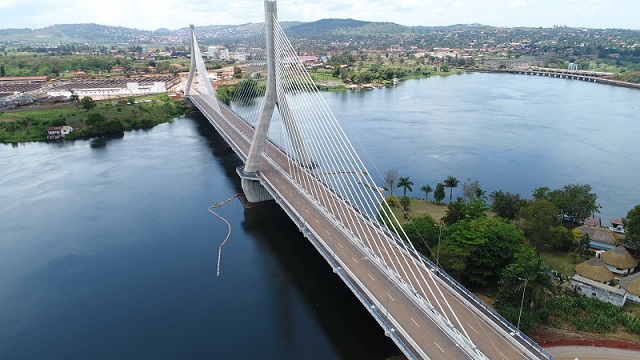
Kampala, Uganda | THE INDEPENDENT | Uganda has a new bridge, after a 14-year wait. The new bridge, officially called the Source of the Nile Bridge, is expected to relieve the old Owen Falls Bridge in the same area, which was commissioned in 1954 and is well past its lifespan of 50 years and in various states of disrepair. The old bridge will now be used for light traffic and motorcycles.
The 525 metre cable stayed bridge hangs on two inverted Y-shaped 69 metre pylon towers with fan shaped cables that are tucked into the concrete of the bridge. With a deck width of 22 metres, it is a four lane, dual carriage way with 2 metre walkways for pedestrians on either side.
President Yoweri Museveni and the Japanese Minister of State for Foreign Affairs Masahisa Sato led the commissioning ceremony of the bridge at a function attended by huge crowds of people excited to be witnessing an historic occasion. Many of them dashed across the bridge to immerse themselves in the new attraction of their town as soon as Museveni’s motorcade drove off after the commissioning.
Museveni explained that the bridge is part of efforts to improve road and rail transport to ease doing business and is expected to bring economic transformation dividends. The bridge lies along the Northern Corridor Route which runs from the Kenya Port of Mombasa, through Uganda to Rwanda, DR Congo and South Sudan.
Construction of the bridge was jointly funded by the governments of Uganda; paying Shs41billion and Japan through the Japan International Cooperation Agency committing (JICA) $112million (Shs420billion).
UNRA awarded the contract in 2013 to a joint venture between Zenitaka Corporation and Hyundai Engineering and Construction Company who completed work after four years.
History
In 2004, the government entered discussions with the World Bank for the funding of the Nile Bridge project. The following year, the World Bank undertook a pre-investment study for the project construction. A similar study was done by International Development Institute in 2006.
In 2008, JICA carried out a feasibility study for the construction of the bridge and for the next four years, carried out a detailed design for the construction paving way for the work to begin. The contractor was procured in 2013 and work commenced in April 2014.
 The Independent Uganda: You get the Truth we Pay the Price
The Independent Uganda: You get the Truth we Pay the Price



Another bridge should be planned imm,such that by 2022 we have another one crossing the nile.Dont wait for emmergencies.